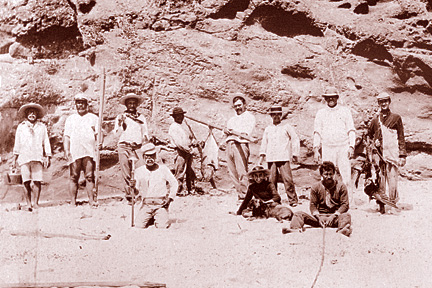
The bluestripe snapper is one of the residents of the bay.
Bay watchers
A new guide respects both history and
Hanauma’s underwater creatures
Sometimes the most precious places are taken for granted, with many people believing that natural beauty ultimately will care for itself. Hanauma Bay is one of those special Hawaii places and, like all of nature's treasures, has needed help to survive after decades of often thoughtless, or stupid, human intervention that decimated much of the marine environment.
"Hanauma Bay: Hawaii's Coastal Treasure"By Cheryl Chee Tsutsumi(Island Heritage, 2005, $9.99)
Down by the bayBook signingsAuthor Cheryl Chee Tsutsumi and photographers Larry Winnik and Veronica Carmona will sign copies of "Hanauma Bay: Hawaii's Coastal Treasure": When: 11 a.m. to 1 p.m. Wednesday and Aug. 10 Place: Hanauma Bay Nature Preserve Admission: Free
Hanauma Bay educational programs
Topics
|
This might be just one of several tomes about the marine reserve, but none have been as wide-ranging, pragmatic, easy to decipher and appreciate. Other books have primarily been marine-life guides covering the bay's history, geology, bird and plant life, mentioning conservation efforts only in passing.
Divided into six chapters, from the practical "Know Before You Go" fast-facts guide and finishing with "Looking Ahead" on ways to protect Hanauma for future generations, Tsutsumi's 119-page book has something for everyone, from malihini to kamaaina.
"In the Beginning" describes the dramatic birth of Hanauma Bay some 100,000 years ago, pinpointing 11 significant areas and displaying several sepia-toned photos dating from nearly a century ago.
Tsutsumi doesn't beat the reader over the head proselytizing, but lets history and facts scream volumes. Hanauma seems to plead, "Hey, people, look at how pristine I was. Take care of me now."
Pictures of Hawaiian families in Sunday garb enjoying a day at Hanauma and proud fishermen holding mega-size ulua take readers back to an innocent time when Hanauma Bay was such an outpost that few families ever visited. It took too long to reach from Honolulu or Windward Oahu.
An aerial photo taken in the early '60s shows mostly undeveloped land -- the beginning of Hawaii Kai's first subdivision -- that will tug at any environmentalist's heart for what's been lost.
Tsutsumi reveals the area's history though Hawaiian legend and modern anecdote. Queen Kaahumanu, wife of King Kamehameha I, was so taken by Hanauma's beauty that it is said she stayed in the area for a month while being "entertained by hula performances and uma competitions." The bay later became a favorite fishing spot for other royalty.
Former President Bill Clinton visited twice, most recently in 1993. Elvis Presley made a couple of films here.

An aerial shot of Hanauma Bay shows the homes of Hawaii Kai in the background.
"From Here to Eternity" author James Jones, stationed at Makapuu Point during World War II, sometimes camped at Hanauma Bay with other soldiers in their free time. The beach was coral-lined and not hospitable to swimmers, so Jones and company reportedly threw hand grenades into the near shore to make a sand beach.
"Some historians doubt the story," Tsutsumi writes.
In 1956, Hawaiian Telephone Co. was allowed to blow a 200-foot-wide opening through Hanauma's reef for its trans-Pacific telephone cable. The explosions also created more swimming space, and the passage became a portal for divers and snorkelers to deep water. The "passageway" and new beach increased the number of Hanauma visitors.
History aside, the stars of the Hanauma Bay show are underwater -- Tsutsumi calls them "Beauties of the Bay." There are few shortcuts in representing dozens of Hanauma's prizes in brilliant, high-quality color with each photograph accompanied by the fish's common, scientific and Hawaiian names, as well as "Distinctions."

This photograph, taken at the turn of the 20th century, shows a group of fishermen and their catch. Only the very determined were able to reach Hanauma Bay in those days, as it lay beyond paved roads from town.
If there are any shortcomings as far as photos, the corals and limu -- all plants living underwater -- are less striking than their finny counterparts. Four pages are used for too-small photos of other Hanauma fish, invertebrates, morays and turtles. In a perfect world, these creatures would have received bigger play.
Tsutsumi spends considerable time describing the area's "Landlubbers," the numerous birds and plants that make up this remarkable ecosystem.
Much thought went into "Hanauma Bay: Hawaii's Coastal Treasure," and it shows.
In an interview, Tsutsumi said she was certain the book would be "cut and dry" when she started the project.
"I figured I'd take a look at the bay in ancient times, explain how it was formed, include highlights of its ... Marine Education Center and talk a bit about the fish, birds and plants. Slam dunk," she said.
Instead, the project mushroomed after hours of interviews with Alan Hong, manager of the preserve, and Peter Rappa, project manager of the Hanauma Bay Education Program, who explained the importance of the bay's designation as a Marine Life Conservation District and the rules that had been established to protect it.
More than two dozen experts, including marine biologists, botanists, geologists, ornithologists and architects, are listed on the book's acknowledgments pages.
"Hanauma Bay: Hawaii's Coastal Treasure" sets a new standard for chronicling the changing history of this enduring marine treasure.
E-mail to Features Desk
[News] [Business] [Features] [Sports] [Editorial] [Do It Electric!]
[Classified Ads] [Search] [Subscribe] [Info] [Letter to Editor]
[Feedback]
